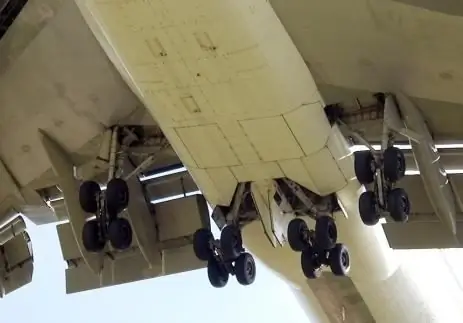2026 Author: Howard Calhoun | [email protected]. Last modified: 2025-01-24 13:10:32

Since the first airplanes took to the air, the continuous improvement of aviation technology has continued. An integral part of each aircraft are devices that serve to move it on land (or water) in order to accelerate before takeoff or decelerate after landing.
It is a fascinating sight to watch how the seemingly bulky mechanical system of the aircraft (chassis), consisting of many elements, after taking off from the runway, easily folds into a compact shape and hides under the shields in its fuselage or wings.
Classic "land" aircraft landing gear consist of two main elements - racks and wheels, also called pneumatics. In cases where it is required to create an opportunity for operation on snow cover or water, some aircraft models provide for the installation of replaceable elements that are in contact with the landing surface, these can be skis or floats.

Until the mid-thirties XXcentury in the world aircraft industry was dominated by a non-retractable design of the aircraft landing gear. It was undoubtedly more reliable, but created a lot of aerodynamic drag, which required various engineering tweaks, such as additional fairings and thinning of the profile of the main pillars. Over time, such a scheme was largely abandoned, although some types of aircraft of the so-called "small" aviation still use it today. An example is the "heavenly long-liver" An-2, the design of which has not been changed since 1949.
The development of fighter aviation required an increase in speed. The struts, previously equipped only with shock absorbers, became more complicated, and the wheel intake mechanism in the plane or the fuselage posed difficult technical problems for the engineers, but the result was worth it. The landing gear of the Il-16 aircraft became a revolutionary solution, they were removed for the first time on a mass-produced fighter, which gave our volunteer pilots the opportunity to win victories in the skies of warring Spain.
In terms of its diversity, few structural elements can compare with the landing gear of an aircraft. The scheme, which has received the greatest distribution in modern aircraft industry, is tricycle. It involves two main racks and one auxiliary (most often - bow, which takes up to 9% of the weight of the aircraft). However, half a century ago, additional support was most often installed on the tail.

Some aircraft designs had, in addition to the main three pillars, also a belay. She took on the burden in the event of an unsuccessfullanding (eg IL-62). With an increase in take-off weight, the two main supports were not enough. The number of pneumatics in the An-124 Ruslan reached 24. The chassis of the Boeing-747 aircraft was also designed according to the multi-rack scheme.
Landing is the most crucial moment in the entire flight, every pilot knows this. Therefore, both the reliability of the design and the materials for the manufacture of landing gear racks are very high requirements. The strong precision alloys from which they are made provide the ability to withstand loads with a multiple margin. And in order to ensure that the number of take-offs always coincides with the number of landings, backup, emergency rack release systems are also created. Just in case.
Recommended:
The main parts of the aircraft. Aircraft device

The invention of the aircraft made it possible not only to fulfill the most ancient dream of mankind - to conquer the sky, but also to create the fastest mode of transport
What types of aircraft are there? Model, type, type of aircraft (photo)

Aircraft construction is a developed branch of the world economy, which produces a wide variety of aircraft, from super light and fast to heavy and large. The world leaders in the production of aircraft are the United States, the European Union and Russia. In this article, we will consider what types of aircraft are in modern aircraft construction, their purpose and some structural features
Aircraft device for dummies. Aircraft device diagram

Few people know how an airplane works. Most don't care at all. The main thing is that it flies, and the principle of the device is of little interest. But there are people who cannot understand how such a huge iron machine rises into the air and rushes at great speed. Let's try to figure it out
Anti-aircraft missile system. Anti-aircraft missile system "Igla". Anti-aircraft missile system "Osa"

The need to create specialized anti-aircraft missile systems was ripe during the Second World War, but scientists and gunsmiths from different countries began to approach the issue in detail only in the 50s. The fact is that until then there simply were no means of controlling interceptor missiles
How does the plane slow down when landing? Types of aircraft and methods of braking

The field of aircraft engineering is of interest to many people, especially those who often fly airplanes. Knowledge of the structure of aircraft will not only make you more erudite, but also relieve many fears, for example, the fear of flying. This article will talk about how the plane slows down during landing and about the methods of braking on different aircraft

